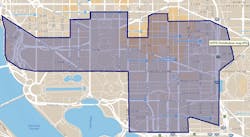Feds Consider Microgrid in Upgrade of Washington, D.C. Energy Backbone
The U.S. government says it will consider installing a microgrid as part of a massive energy upgrade planned for a large block of buildings in Washington, D.C.
The General Services Administration issued a request for information (RFI) Friday in the first step to upgrade the 81-year-old district energy network and younger combined heat and power (CHP) system. The RFI is precursor to an energy request for proposals to be issued at a later date.
The federal government also wants to find ways to monetize the system and will consider outsourcing.
Known as the Heating Operations & Transmission District, or HOTD, the electric and thermal system now provides steam to 71 buildings and chilled water to 11 buildings. The operation includes 12 miles of tunnels and buried lines.
The GSA-owned system has “1940s era equipment” that is functional but not efficient, according to the RFI.
The federal government envisions the HOTD serving as the generation source for a possible microgrid. It wants a new, greener system that offers energy security and reliability and possibly new revenue streams and alternative business and ownership models.
Built as a steam network in 1934, the system was expanded to offer chilled water in 1957. Coal fueled the steam boilers originally. But in the early 1990s the government converted the system to natural gas with oil as a backup.
In the mid-2000s, the federal government added the CHP system and new chiller capacity, under an energy services agreement with a private firm. Like the district energy system, the CHP plant uses natural gas as a primary fuel and oil as a backup. It supplies electricity onsite and exports excess power to the distribution grid. The GSA raises the possibility of using the excess electric capacity in a microgrid.
Map of Washington, DC’s HOTD. Source US GSA
While the system has served the federal government well for 80 years, it now faces several problems related to its age and market changes.
Today, the buildings demand less steam from the system because they have become more efficient or have added on-site heating systems. Remaining customers therefore face higher steam costs since there are fewer of them to pay for the system.
This system’s economic woes are compounded by the way the buildings use energy. Most are traditional office buildings, so they all tend to use energy around the same time – during the work day. The plant had to be built with a large enough capacity to meet the day-time need. But during non-work hours much of that capacity goes wasted.
“At the same time, GSA is facing mounting capital costs to address aging infrastructure, system reliability, deferred maintenance, and evolving technology and regulatory requirements,” the RFI says.
The GSA wants to leverage the expertise of the energy industry “to explore whether and how specialized private sector (such as energy utility/systems operators) might be able to assist federal authorities in optimizing HOTD performance,” the RFI says.
Responses are due December 22 to Kathy White, GSA contracting officer, [email protected]. The RFI is available for download at Federal Business Opportunities, GS-11-P-16-YE-P-0000.Track microgrid opportunities by subscribing to the free Microgrid Knowledge newsletter.
About the Author
Elisa Wood
Editor-in-Chief
Elisa Wood is the editor and founder of EnergyChangemakers.com. She is co-founder and former editor of Microgrid Knowledge.
